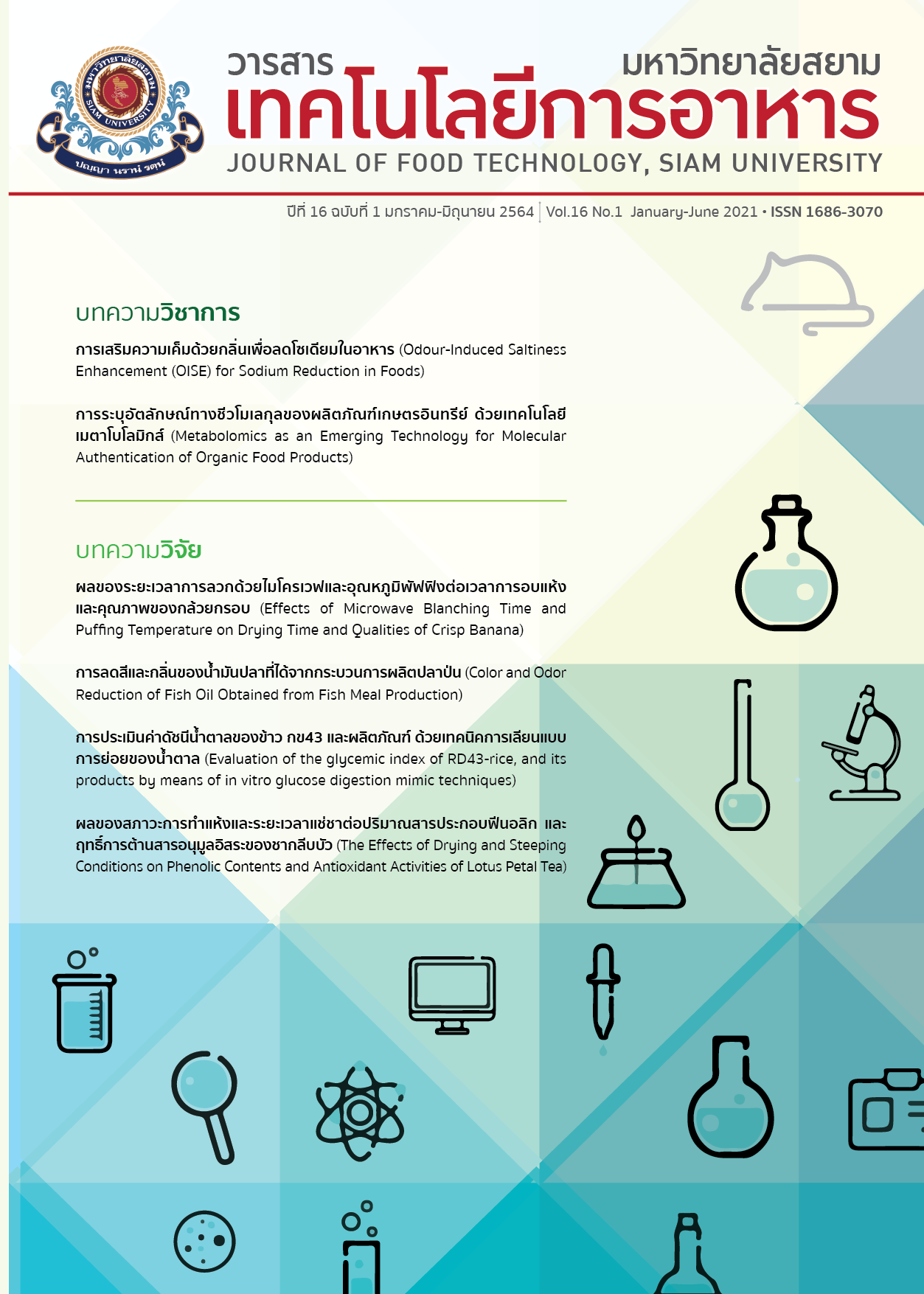Color and Odor Reduction of Fish Oil Obtained from Fish Meal Production
Main Article Content
Abstract
In the process of fish meal production, a large amount of crude fish oil as waste is obtained. However, utilization of crude fish oil is limited due to its dark color and intense fishy odor. This study was aimed to determine the optimum purification condition for bleaching and deodorization of crude fish oil obtained from fish meal production. The crude fish oil was purified by degumming, neutralization and bleaching with activated carbon compared with activated bleaching earth at 4, 5 and 6% (w/v of the oil). The purified oils were subject to color, acid value, peroxide value and fatty acid profile evaluation. It was found that bleached fish oils obtained from the optimum condition (activated bleaching earth at 5% (w/v)) showed a higher L* value and a lower Gardner scale than that did with activated carbon. In addition, redness (a*) and yellowness (b*) was decreased and the content of polyunsaturated fatty acid was highly maintained. The bleached fish oil selected was further deodorized at 170, 180 and 190 °C and subject to fatty acid profile analysis and sensory evaluation. Results revealed that major fatty acid composition including palmitic acid, linoleic acid, eicosapentaenoic acid and docosahexaenoic acid was not affected by deodorization process. Deodorization process at 170 °C was sufficient to decrease fishy odor of crude fish oil. Sensory evaluation revealed that purified fish oil showed the mean intensity of fishy odor close to that of commercial fish oil.
Article Details
Copyrights of all articles in the Journal of Food Technology available in print or online are owned by Siam University and protected by law.
References
Department of Fishery Products. (2015). Fishery Product Science and Technology. Bangkok: Kasetsart University Press. (in Thai).
Department of Foreign Trade, Office of Commodity Standards. (2020). Export data of fish meal December 2019. Retrieved June 1, 2020 from https://www.dft.go.th/th-th/DFT-Service/Service-Data-Information/Statistic-Import-Export/Detail-dft-service-data-statistic/ArticleId/14534/14534. (in Thai).
García-Moreno, P.J., Guadix, A., Gómez-Robledo, L., Melgosa, M. and Guadix, E.M. (2013). Optimization of bleaching conditions for sardine oil. Journal of Food Engineering. 116(2): 606-612.
de Oliveira, D.A.S.B., Minozzo, M.G., Licodiedoff, S. and Waszczynskyj, N. (2016). Physicochemical and sensory characterization of refined and deodorized tuna (Thunnus Albacares) by-product oil obtained by enzymatic hydrolysis. Food Chemistry. 207: 187-194.
Joshi, A., Mehendale, S.S., Yadav, H. and Joshi, S. (2011). Reduced placental docosahexaenoic acid levels associated with increased levels of sFlt-1 in preeclampsia. Prostaglandins, Leukotrienes and Essential Fatty Acids. 84(1-2): 51-55.
Vaisali, C., Charanyaa, S., Belur, P.D. and Regupathi, I. (2015). Refining of edible oils: A critical appraisal of current and potential technologies. International Journal of Food Science and Technology. 50(1): 13-23.
American Oil Chemists’ Society (AOCS). (1997). AOCS Official Methods and Recommended Practices Cd 3d-63: Acid Value. Illinois: AOCS press.
American Oil Chemists’ Society (AOCS). (1998). AOCS Official Methods and Recommended Practices Cc 8b-53: Peroxide Value. Illinois: AOCS press.
American Oil Chemists’ Society (AOCS). (1997). AOCS Official Methods and Recommended Practices Cd 1b-89: Fatty Acid Composition by GLC. Illinois: AOCS press.
Meilgaard, M., Civille, G.V. and Carr, T. (2007). Sensory evaluation technique (4th ed.). CRC Press, Florida.
Ratanasiriwat, P., Worawattanamateekul, W. and Klaypradit, W. (2013). Properties of encapsulated wasabi flavour and its application in canned food. International Journal of Food Science and Technology. 48(4): 749-757.
Guliyev, N.G., Ibrahimov, H.J., Alekperov, J.A. (2018). Investigation of activated carbon obtained from the liquid products of pyrolysis in sunflower oil bleaching process. International Journal of Industrial Chemistry. 9: 277–284.
Noriega-Rodríguez, J.A., Ortega-García, J., Angulo-Guerrero, O., Garcia, H.S., Medina-Juárez, L.A. and Gámez-Meza, N. (2009). Oil production from sardine (Sardinops sagax caerulea). CyTA - Journal of Food. 7(3): 173-179.
Food and Agriculture Organization of the United Nations, World Health Organization. (2017). Alimentarius international food standards. Rome: Food and Agriculture Organization.
Mata, T.M., Mendes, A.M., Caetano, N.S. and Martins, A.A. (2013). Properties and sustainability of biodiesel from animal fats and fish oil. Chemical Engineering Transactions. 38: 175-180.
Boran, G., Karaçam, H. and Boran, M. (2006). Changes in the quality of fish oils due to storage temperature and time. Food Chemistry 98(4): 693-698.
Akoh, C. and Min, D. (2002). Food lipids: chemistry, nutrition, biotechnology (2nd ed.). CRC Press, Florida.
Bimbo, A.P. (1990). Processing of fish oils. pp. 181-222. Ln M. E. Stanby, ed. Fish Oils in Nutrition. Van Nostrand Reinhold, New York.
Food and Agriculture Organization of the United Nations, World Health Organization. (2010). Alimentarius international food standards. Rome: Food and Agriculture Organization.
Zatsick, M.N. and P. Mayket. 2007. Fish oil: getting to be the heart of it. International Journal of Nursing Practice 3: 104-109
Gbogouri, G.A., Linder, M., Fanni, J. and Parmentier, M. (2006). Influence of hydrolysis degree on the functional properties of salmon byproducts hydrolysates. Journal of Food Science 69(8): 615-622.
Wu, T. and Bechtel, P. (2008). Salmon by-product storage and oil extraction. Food Chemistry. 111(4): 868-871.
Crexi, V., Grunennvaldt, F., Soares, L. and Pinto, L. (2009). Deodorisation process variables for croaker (M. Furnieri) Oil. Food Chemistry 114(2): 396-401.


